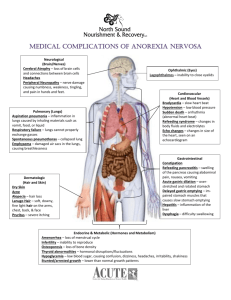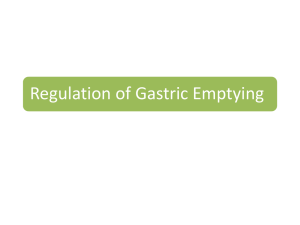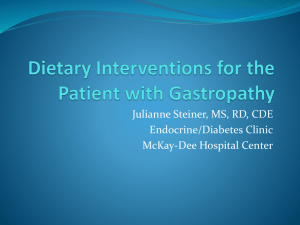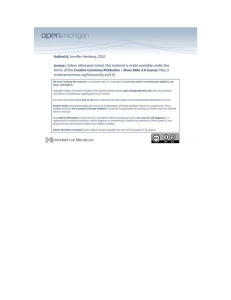Diapositiva 1
advertisement
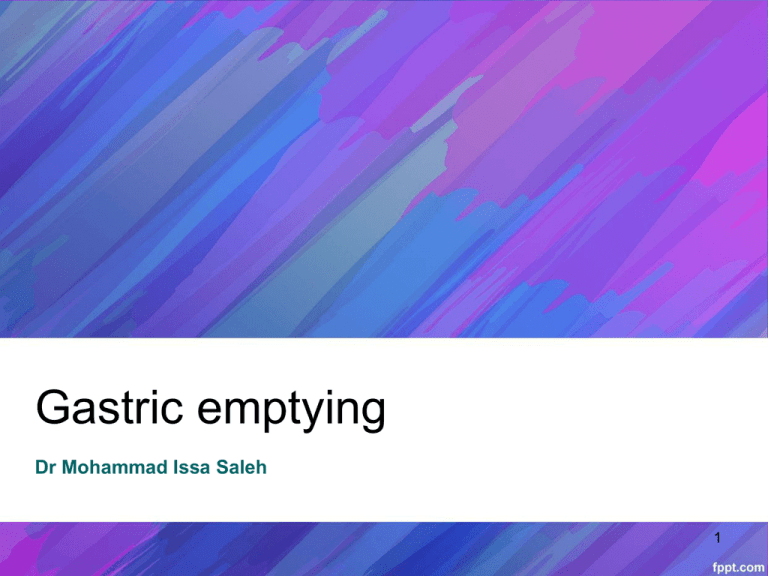
Gastric emptying Dr Mohammad Issa Saleh 1 Gastric emptying • After a meal, the digestible food will have been processed to chyme and passed to the small intestine leaving a residue of mucus and undigested solids • Undigested solids remain in the stomach until the small intestine has finished absorbing nutrients from the chyme i.e. approximately 2 h after the last of the digestible food has left the stomach 2 Gastric emptying: Fasted state • At this point the digestive phase of activity ceases and is replaced by the interdigestive phase, which is also the normal resting condition of the stomach and small intestine (i.e. under fasting) • All gastric residues which the stomach has failed to process to chyme are removed in this phase, the migrating myoelectric complex (MMC) or so called ‘housekeeper 3 contractions’ Migrating Myoelectric Complex (MMC) • MMC is a propulsive movement that empties the upper GI tract to the cecum • Under fasting conditions, MMC occurs every two hours until a meal is eaten • Under fed conditions, MMC stops until 2 hours after the stomach has been cleared of the digestible components of the meal 4 Gastric emptying: Fed state • Solids and liquids do not empty from the stomach together as a homogeneous mass (Figure) • Liquids empty according to the pressure gradient between the stomach and duodenum, with isotonic liquid meals emptying more rapidly than hypotonic or hypertonic mixtures 5 Gastric emptying: Fed state • Larger particles require a longer period of digestion to break them down into a size suitable to exit through the pylorus • Small indigestible solids of size between 1 to 5 mm in diameter are progressively emptied during the whole postprandial period even before liquid emptying is completed 6 Gastric emptying: liquid vs. solid Which one is faster? 7 Gastric emptying of dosage forms • The gastric emptying of tablets, pellets and liquids is highly dependent on the presence and amount of food in the stomach • Large disintegrating tablets disintegrate in the stomach and empty with the digestible phase of the meal • Large non-disintegrating tablets will empty with MMC. Large non-disintegrating tablet emptying will appear erratic, occurring any time between a few minutes and 3 hours after administration 8 Gastric emptying of dosage forms • When a large unit is given after a light meal (1500 kJ) the emptying becomes more predictable at around 2 to 3 hours • The meal serves to put the motility cycle into phase by initiating the fed pattern until the small calorific load has been passed to the duodenum • The next MMC then removes the tablet approximately 2 hours after the stomach has been cleared of the digestible components of the meal 9 Gastric emptying of dosage forms • If a large single unit is given with a heavy meal (3600 kJ) and the subject is fed at regular intervals, the unit can remain in the stomach for longer than 8 hours due to prolonged suppression of the MMC 10 Gastric emptying of dosage forms • Dosage forms are often administered to fasting subjects during pharmacokinetic studies in an attempt to reduce variability • The effect of erratic emptying can affect the time of appearance of the drug in the plasma. • If the formulation is given with food to synchronise motility, the absorption of the drug can be influenced by the food • A possible solution is to give the drug with apple juice, which is a clear liquid, but has sufficient 11 calories to synchronise gastric motility Factors Influencing Gastric Emptying Factor Influence on Gastric Emptying 1-Volume The larger the starting volume, the greater the initial rate of emptying, after this initial period, the larger the original volume, the slower the rate of emptying. 2-Type of meal A-Fatty acids Reduction in rate of emptying is in direct proportion to their concentration and carbon chain length; little difference is detected from acetic to octanoic acids; major inhibitory influence is seen in chain lengths greater than 10 carbons (decanoic to stearic acids). B-Triglycerides Reduction in rate of emptying; unsaturated triglycerides are more effective than saturated ones in reducing emptying rate C-Carbohydrates Reduction in rate emptying, primarily as a result of osmotic pressure; inhibition of emptying increases as concentration increases. D-Amino acids Reduction in rate of emptying to an extent directly dependent upon concentration, probably as a result of osmotic pressure. 12 Factors Influencing Gastric Emptying Factor Influence on Gastric Emptying 3-Physical state of gastric contents Solutions or suspensions of small particles empty more rapidly than do chunks of material that must be reduced in size prior to emptying. 4-Chemicals A-Acids B-Alkali (NaHCO3) Reduction in rate of emptying dependent upon concentration and molecular weight of the acid; lower molecular weight acids are more effective than those of higher molecular weight (in order of decreasing effectiveness: HCl, acetic, lactic, tartaric, citric acids). Increased rate of emptying at low concentrations (1%), and decreased rate at higher concentrations (5%). 5-Drugs A-Anticholinergics B-Narcotic analgesics Reduction in rate of emptying. Reduction in rate of emptying. C-Metoclopramide D-Ethanol Increase in rate of emptying. Reduction in rate of emptying. 13 Factors Influencing Gastric Emptying Factor Influence on Gastric Emptying 6-Miscellaneous A-Body position Rate of emptying is reduced in a patient laying on left side. B-Viscosity Rate of emptying is greater for less viscous solutions. C-Emotional Aggressive or stressful emotional states increase stomach contractions and states emptying rate; depression reduces stomach contraction and emptying. D-Bile salts Rate of emptying is reduced. E-Disease states Rate of emptying is reduced in some diabetics and in patients with local pyloric lesions (duodenal or pyloric ulcers; pyloric stenosis) and hypothyroidism; gastric emptying rate is increased in hyperthyroidism. F-Exercise Vigorous exercise reduces emptying rate. 14

